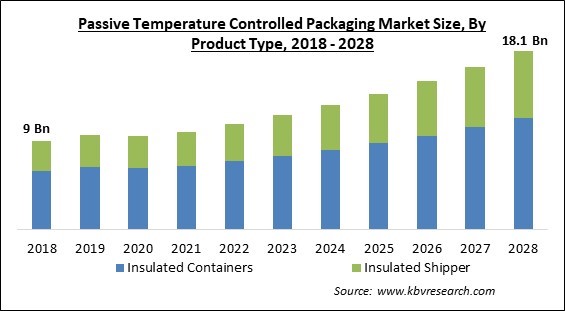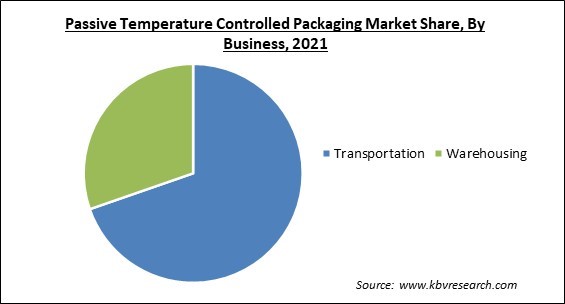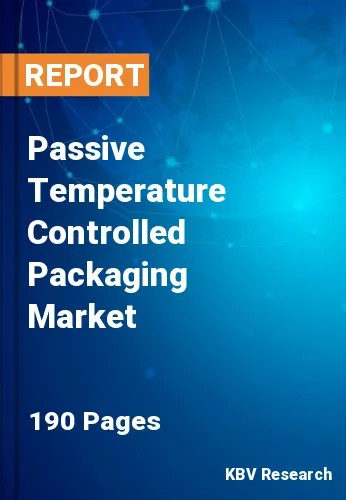The Global Passive Temperature Controlled Packaging Market size is expected to reach $18.1 billion by 2028, rising at a market growth of 9.2% CAGR during the forecast period.
Passive temperature controlled packaging is the process of packaging that keeps the temperature of the goods at an adequate level for a particular duration of time. The process includes packaging and cooling of goods that need to be transported. Several pharmaceutical products are highly temperature sensitive and can be exposed to too high or too low-temperature environments. Therefore, high preventive measures are required to maintain the relevant temperature. The shipment of small parcels by road in a temperature-controlled manner is costly. In this situation, passive packaging can be the right solution to be adopted.

Passive temperature controlled packaging mainly uses small boxes to pallet size and also in containers. The time till when the product is considered to be at adequate temperature depends on specifications such as type of box used, quantity & type of coolant used. . The coolants utilized while packaging consists of water, dry ice, vacuum insulation panels and PCM (Phase Change Material). The ideal temperature range of passive temperature controlled packaging is between -70 and +25 degrees Celsius.
The supplier of the passive temperature controlled packaging tests the process and provides confirmation before serving out in the market. The suppliers also provide a report that consists of details regarding the performance of passive temperature controlled packaging in various situations. Consumers must ensure the packaging by themselves and validate it for use.
The outspread of COVID-19 has adversely impacted the livelihood and economy of world. Lockdowns were imposed across the affected nations as a preventive measure to control the spread of the virus. The implemented restrictions along with the lockdowns severely affected trade, economy, and finance across the world by disrupting the supply chains. A considerable amount of reduction has been seen in the manufacturing of temperature-controlled packaging systems during the pandemic period. The increasing demand from the pharmaceutical industry for the delivery of various sensitive products such as COVID-19 vaccines and blood supported the rapid recovery of the passive temperature-controlled packaging market.
Passive temperature controlled packaging can also be reused, which is one of the major reasons resulting in increased demand for these systems. With few changes and improvements in the passive temperature-controlled packaging, it provides with reverse logistic capabilities. This provides the opportunity to the supplier to repack and redistribute products. Presently, several reasons have made manufacturers use reusable containers for commercial benefits. The unique ability of reusability offered by the passive temperature controlled packaging is anticipated to support then market growth during the projected period.
Vaccines, blood, blood elements, cells, allergens, genes, tissue, and recombinant protein are examples of biosimilar products. Globally, the burden of chronic diseases has increased. The ageing population and shifting lifestyles of the people can be partly blamed for the rise in the prevalence of chronic diseases. Some of the most prevalent chronic diseases include diabetes, hypertension, stroke, respiratory and oral illnesses, obesity, arthritis, and cancer. The treatment of cancer and rheumatoid arthritis with biosimilar monoclonal antibodies is widely employed.
The major problem faced by the market is the improper knowledge of customs personals for temperature-sensitive products. The delay in the shipment of the products by the custom and the opening & checking of the products that may cause temperature disturbance surges the chances of damaging temperature-sensitive products. Furthermore, the government regulation for compliance of products changes from nation to nation.
On the basis of product type, the passive temperature controlled packaging market is segmented into insulated shippers and insulated containers. In 2021, the insulated containers segment dominated the passive temperature-controlled packaging market with maximum revenue share. Various medicines and medical products need a specific temperature for availability. The insulated container is ideal for maintaining the temperature of the sensitive products.

Based on business, the passive temperature controlled packaging market is fragmented into warehousing and transportation. In 2021, the warehousing segment covered a substantial revenue share in the passive temperature-controlled packaging market. The warehousing process includes the maintenance of the required temperature of temperature-sensitive items as advised by the manufacturer. While warehousing, it is necessary to measure and track that equipment should be calibrated and tested at a particular time interval.
By end user, the passive temperature controlled packaging market is classified into food & beverages and pharmaceuticals. In 2021, the food & beverages segment accounted the largest revenue share in the passive temperature-controlled packaging market. The food & beverage industry produces a lot of perishable products that are highly temperature sensitive, for example, ice creams, beverages, fruits, and others. Transportation of these items needs a passive temperature-controlled packaging solution that helps to avoid spoilage of these items.
| Report Attribute | Details |
|---|---|
| Market size value in 2021 | USD 9.9 Billion |
| Market size forecast in 2028 | USD 18.1 Billion |
| Base Year | 2021 |
| Historical Period | 2018 to 2020 |
| Forecast Period | 2022 to 2028 |
| Revenue Growth Rate | CAGR of 9.2% from 2022 to 2028 |
| Number of Pages | 190 |
| Number of Tables | 330 |
| Report coverage | Market Trends, Revenue Estimation and Forecast, Segmentation Analysis, Regional and Country Breakdown, Companies Strategic Developments, Company Profiling |
| Segments covered | Product Type, Business, End user, Region |
| Country scope | US, Canada, Mexico, Germany, UK, France, Russia, Spain, Italy, China, Japan, India, South Korea, Singapore, Malaysia, Brazil, Argentina, UAE, Saudi Arabia, South Africa, Nigeria |
| Growth Drivers |
|
| Restraints |
|
Region wise, the passive temperature controlled packaging market is analyzed across North America, Europe, Asia Pacific, and LAMEA. In 2021, the Asia Pacific region witnessed the largest revenue share in the passive temperature controlled packaging market. The continuously rising population in the regional countries is further increasing the demand for temperature-sensitive pharmaceutical products and food & beverages. Additionally, the availability of the key providers of passive temperature packaging solutions and the growing use of these solution for a variety of food & beverage is resulting in the growth of regional market.
Free Valuable Insights: Global Passive Temperature Controlled Packaging Market size to reach USD 18.1 Billion by 2028
The market research report covers the analysis of key stake holders of the market. Key companies profiled in the report include Sonoco Products Company, Deutsche Post DHL Group (The Deutsche Post AG), FedEx Corporation, AmerisourceBergen Corporation, Cold Chain Technologies (Aurora Capital Partners), Csafe Global (Softbox Systems), Sofrigam S.A., Atlas Roofing Corporation (Atlas Molded Products) (Hood Companies, Inc.), Intelsius (DGP Group) and Peli BioThermal Limited (Pelican Products, Inc.)
By Product Type
By Business
By End Use
By Geography
The global Passive Temperature Controlled Packaging Market size is expected to reach $18.1 billion by 2028.
Passive packaging technologies can be reused are driving the market in coming years, however, Lack of infrastructure for shipment of temperature sensitive products restraints the growth of the market.
Sonoco Products Company, Deutsche Post DHL Group (The Deutsche Post AG), FedEx Corporation, AmerisourceBergen Corporation, Cold Chain Technologies (Aurora Capital Partners), Csafe Global (Softbox Systems), Sofrigam S.A., Atlas Roofing Corporation (Atlas Molded Products) (Hood Companies, Inc.), Intelsius (DGP Group) and Peli BioThermal Limited (Pelican Products, Inc.)
The expected CAGR of the Passive Temperature Controlled Packaging Market is 9.2% from 2022 to 2028.
The Transportation market is leading the segment in the Global Passive Temperature Controlled Packaging Market by Business in 2021; thereby, achieving a market value of $11.8 Billion by 2028.
The Asia Pacific market dominated the Global Passive Temperature Controlled Packaging Market by Region in 2021; thereby, achieving a market value of $6.5 Billion by 2028.
Our team of dedicated experts can provide you with attractive expansion opportunities for your business.

